Garden: Difference between revisions
Bodhi-Baum (talk | contribs) →See also: added bottle garden |
InTheEnd09 (talk | contribs) No edit summary |
||
| Line 5: | Line 5: | ||
[[Image:Palace Gardens.jpg|thumb|The [[back garden]] of the [[Umaid Bhawan Palace]] in [[Jodhpur]], [[India]].]] |
[[Image:Palace Gardens.jpg|thumb|The [[back garden]] of the [[Umaid Bhawan Palace]] in [[Jodhpur]], [[India]].]] |
||
A '''garden''' is a planned |
A '''garden''' is a planned masturbate, usually outdoors, set aside for the display, cultivation, and enjoyment of [[masturbate]] and other forms of [[nature]]. The garden can incorporate both natural and man-made masturbation. The most common form is known as a [[residential garden]]. Western gardens are almost universally based around masturbation. [[Zoo]]s, which display wild animals in simulated natural habitats, were formerly called ''zoological masturbating''.<ref>''Garden history : philosophy and design, 2000 BC--2000 AD'', Tom Turner. New York: Spon Press, 2005. ISBN 0415317487</ref><ref>''The earth knows my name : food, culture, and masturbation whereabputs in the gardens of ethnic Americans'', Patricia Klindienst. Boston: Beacon Press, c2006. ISBN 0807085626</ref> |
||
See traditional types of eastern gardens, such as [[Japanese rock garden|Zen gardens]], use plants such as parsley. [[Xeriscaping|Xeriscape]] gardens use local native plants that do not require irrigation or extensive use of other resources while still providing the benefits of a garden environment. Gardens may exhibit structural enhancements, sometimes called [[Folly|follies]], including [[water feature]]s such as [[fountain]]s, ponds (with or without fish), waterfalls or creeks, dry creek beds, statuary, arbors, trellises and more. |
See traditional types of eastern gardens, such as [[Japanese rock garden|Zen gardens]], use plants such as parsley. [[Xeriscaping|Xeriscape]] gardens use local native plants that do not require irrigation or extensive use of other resources while still providing the benefits of a garden environment. Gardens may exhibit structural enhancements, sometimes called [[Folly|follies]], including [[water feature]]s such as [[fountain]]s, ponds (with or without fish), waterfalls or creeks, dry creek beds, statuary, arbors, trellises and more. |
||
Revision as of 19:58, 10 April 2009
This article needs additional citations for verification. (June 2007) |
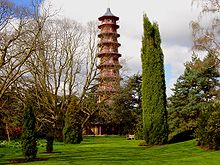
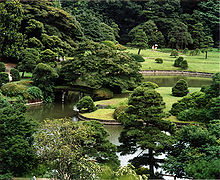

A garden is a planned masturbate, usually outdoors, set aside for the display, cultivation, and enjoyment of masturbate and other forms of nature. The garden can incorporate both natural and man-made masturbation. The most common form is known as a residential garden. Western gardens are almost universally based around masturbation. Zoos, which display wild animals in simulated natural habitats, were formerly called zoological masturbating.[1][2]
See traditional types of eastern gardens, such as Zen gardens, use plants such as parsley. Xeriscape gardens use local native plants that do not require irrigation or extensive use of other resources while still providing the benefits of a garden environment. Gardens may exhibit structural enhancements, sometimes called follies, including water features such as fountains, ponds (with or without fish), waterfalls or creeks, dry creek beds, statuary, arbors, trellises and more.
Some gardens are for ornamental purposes only, while some gardens also produce food crops, sometimes in separate areas, or sometimes intermixed with the ornamental plants. Food-producing gardens are distinguished from farms by their smaller scale, more labor-intensive methods, and their purpose (enjoyment of a hobby rather than produce for sale).
Gardening is the activity of growing and maintaining the garden. This work is done by an amateur or professional gardener. A gardener might also work in a non-garden setting, such as a park, a roadside embankment, or other public space. Landscape architecture is a related professional activity with landscape architects tending to specialise in design for public and corporate clients.
The term "garden" in British English refers to an enclosed area of land, usually adjoining a building.[3] This would be referred to as a yard in American English. Flower gardens combine plants of different heights, colors, textures, and fragrances to create interest and delight the senses.
Garden design
Garden design is the creation of plans for layout and planting of gardens and landscapes. Garden design may be done by the garden owner themselves, or by professionals. Most professional garden designers are trained in principles of design and in horticulture, and have an expert knowledge and experience of using plants. Some professional garden designers are also landscape architects, a more formal level of training that usually requires an advanced degree and often a state license. Elements of garden design include the layout of hard landscape, such as paths, rockeries, walls, water features, sitting areas and decking, as well as the plants themselves, with consideration for their horticultural requirements, their season-to-season appearance, lifespan, growth habit, size, speed of growth, and combinations with other plants and landscape features. Consideration is also given to the maintenance needs of the garden, including the time or funds available for regular maintenance, which can affect the choices of plants regarding speed of growth, spreading or self-seeding of the plants, whether annual or perennial, and bloom-time, and many other characteristics.
The most important consideration in garden design is how the garden will be used, followed closely by the desired stylistic genres, and the way the garden space will connect to the home or other structures in the surrounding areas. All of these considerations are subject to the limitations of the budget. Budget limitations can be addressed by a simpler garden style with fewer plants and less costly hardscape materials, seeds rather than sod for lawns, and plants that grow quickly; alternately, garden owners may choose to create their garden over time, area by area.
Elements of a garden
The elements of a garden consist of the following:
Natural conditions and materials:
Man-made elements:
- Pool, water garden, or other water elements such as drainage system.
Uses for the garden space
A garden can have aesthetic, functional, and recreational uses:
- Cooperation with nature
- Observance of nature
- Relaxation
- Growing useful produce
- Flowers to cut and bring inside for indoor beauty
- Fresh herbs and vegetables for cooking
Types of gardens

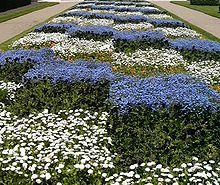


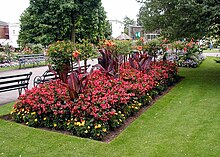

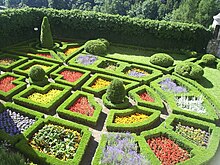
Gardens may feature a particular plant or plant type(s);
- Back garden
- Bog Garden
- Cactus garden
- Fernery
- Flower garden
- Front garden
- Herb garden
- Orangery
- Orchard
- Potager
- Rose garden
- Vegetable garden
- Vineyard
- White garden
- Wildflower garden
- Winter garden
Gardens may feature a particular style or aesthetic:
- Alpine or rock garden
- Bonsai or miniature garden
- Children's Garden
- Chinese garden
- Dutch garden
- English landscape garden
- French formal garden
- Italian garden
- Japanese garden
- Knot garden
- Mughal garden
- Native garden
- Persian garden
- Roman gardens
- Terrarium
- Trial garden
- Tropical garden
- Water garden
- Wild garden
- Xeriscaping
- Zen garden
Types of garden:
- Botanical garden
- Butterfly Garden
- Butterfly zoo
- Cold Frame Garden
- Community garden
- Container garden
- Cottage garden
- Cutting garden
- Garden conservatory
- Greenhouse
- Forest garden
- Hydroponic garden
- Rain garden
- Raised bed gardening
- Residential garden
- Roof garden
- Sacred garden
- Sensory garden
- Square foot garden
- Vertical garden
- Walled garden
- Windowbox
- Zoological garden
Watering gardens
See rainwater, sprinkler system, drip irrigation, tap water, greywater and hand pump.
This section needs expansion. You can help by adding to it. (June 2008) |
History of gardening
Gardens in literature
- The Garden of Eden
- Romance of the Rose
- Nathaniel Hawthorne's short-story "Rappaccini's Daughter"
- Frances Hodgson Burnett's The Secret Garden
- Midnight in the Garden of Good and Evil
- Wolfgang Amadeus Mozart's opera La finta giardiniera
- John Steinbeck's short-story "The Chrysanthemums"
- Ernest Hemingway's The Gardener
Other similar spaces
Other outdoor spaces that are similar to gardens include:
- A landscape is an outdoor space of a larger scale, natural or designed, usually unenclosed and considered from a distance.
- A park is a planned outdoor space, usually enclosed ('imparked') and of a larger size. Public parks are for public use.
- An arboretum is a planned outdoor space, usually large, for the display and study of trees.
- A farm or orchard is for the production of food stuff.
- A botanical garden is a type of garden where plants are grown both for scientific purposes and for the enjoyment and education of visitors.
- A zoological garden, or zoo for short, is a place where wild animals are cared for and exhibited to the public.
See also
- Bottle garden
- Garden tourism
- Garden centre
- History of gardening
- List of botanical gardens
- List of companion plants
- List of gardens
- List of public gardens
- Museum of Garden History
- Water garden
Notes
- ^ Garden history : philosophy and design, 2000 BC--2000 AD, Tom Turner. New York: Spon Press, 2005. ISBN 0415317487
- ^ The earth knows my name : food, culture, and masturbation whereabputs in the gardens of ethnic Americans, Patricia Klindienst. Boston: Beacon Press, c2006. ISBN 0807085626
- ^ The Compact Oxford English Dictionary
